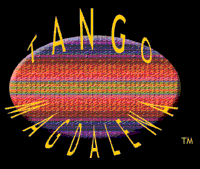
 |

|
|
Dancing and Loving By Jean-Pierre Sighé
The desire to dance well inspires the courage to engage in the learning process. Class after class, workshop after workshop, students gradually acquire the necessary techniques to excel in expressing the dance. Once a student enters that citadel of the archetypal dancer, the rules and codes dispensed become understandably essential - in a sense sacred - in order to achieve the immediate goal of mastering the technique relative to the specific dance sought. In the context of Tango, this mechanism imposes itself rather quickly as the moves gain complexity and beauty. Once lost in the effort, the student begins an obsession with the art of the dance. However, it is important that the process remains pragmatic and rooted in the reality of the social interaction. What good does it do to become an experienced complex-figures-loaded individual, if the social interaction on the dance floor lacks consideration to other dancers, or if the pleasure of the dance is not communicated to the partner? The learning process requires many key elements. For one, a fancy move should not break the flow of the dance, but rather embellish it. In addition, a fancy move should not throw anyone off balance, but rather allow for the generation of an unexpected new space. The continuity of the dance, in turn, implies a connection to the music and a musical presence or oneness. The man would therefore make sure the woman is enjoying the music as well as any sudden fancy move he pulls out of his sleeves; whereas the woman would punctuate her walking with a sudden embellishment, such as the amague or the golpecito, conveying to the man her presence IN the music. This back and forth between partners reveals the dance, yet more importantly allows for a deeper connection. Proper technique genuinely serves such connections, but ultimately, dancers must begin with the awareness of such connection as their goal. To dance, is to offer a communion to a partner; is to BE,
here and now, with a partner; is to allow an expansion of oneself, yet letting in the expansion of the other; is to let the subtle nature of music infuse the space temporarily shared. In the end, it amounts to expressing … Love. Here, the imperfections or “accidents” encountered should not break the dance. If, for instance, the partner cannot execute an ocho, or lacks the information on how to do it then let’s avoid the ocho and create a different step. If the volcada is a total mystery, let’s put it aside, rather than forcing it and breaking the flow of the dance. Besides, in Tango, the vocabulary is constructed on the alphabet of the Walking. So… let’s walk… walk and stay with the partner, immersing our souls in the music. At the end of the dance, no one remembers the sacadas and other fancy moves executed. But we do remember the general feeling of a good connection. Dancing as one unit requires a connection and presence; this should be the dancer’s goal without depending on the partner to be. After all, isn’t it taught that all is movement and that all flows from within as from without? May we dance and express Love.
© December 2008
|
|
| Tango Magdalena's Home Page | Contact Us | | ©2007-2010 Tango Magdalena |